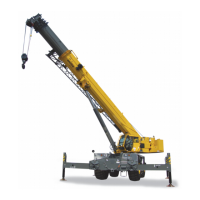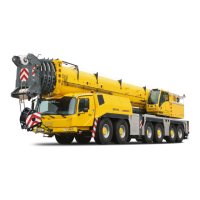7-22 Published 11-22-2016, Control # 345-12
POWER TRAIN RT9130E-2 SERVICE MANUAL
Fans and Belts
The fan should be checked for cracked or broken blades.
Refer to Engine Drive Belts, page 7-4.
Thermostat
The thermostat is of the nonadjustable type and is
incorporated in the cooling system for the purpose of
retarding or restricting the circulation of coolant during
engine warm up. Engine overheating and loss of coolant is
sometimes due to an inoperative thermostat. To check for
this condition, remove the thermostat and test by
submerging it in hot water and noting the temperature at
which the thermostat opens and closes. Use an accurate
high temperature thermometer for making this test.
Hoses and Clamps
Hoses and their connections must be checked regularly
because they are often the source of hidden trouble. Hoses
may often times appear in good condition on the outside
while the inside will be partially deteriorated. If there are any
doubts about a hose doing its job, replacement should be
made. The clamps should be inspected to make sure they
are strong enough to hold a tight connection.
Test Equipment
The antifreeze/coolant concentration must be checked using
a refractometer. “Floating ball” type density testers or
hydrometers are not accurate enough for use with heavy
duty diesel cooling systems.
Antifreeze/Coolant
Heavy duty diesel engines require a balanced mixture of
water and antifreeze/coolant. Fill the system with a 50/50
blended, fully formulated extended life antifreeze/coolant at
all times. Refer to Lubrication, page 9-1. Do not use more
than 50 percent antifreeze/coolant in the mixture unless
additional freeze protection is required. Never use more than
68 percent antifreeze/coolant under any condition.
Antifreeze/coolant at 68 percent provides the maximum
freeze protection; antifreeze/coolant protection decreases
above 68 percent.
Radiator Removal and Installation
Removal
1. Set the outriggers and position the boom to over the
side.
2. Open the drain cock at the end of drain hose and drain
the coolant into a suitable container. If necessary,
dispose of the coolant in accordance with local and EPA
regulations.
3. Open the air bleed pet cock to ensure proper draining.
4. Open and remove the hood top door assembly.
5. Remove the hardware securing the rear engine hood
panel to the engine hood. This will gain access to the
rear of the radiator.
6. Remove the engine hood assembly.
7. Tag and disconnect the hoses from the surge tank to the
engine and from the surge tank to the radiator. Remove
surge tank assembly.
8. Remove the hose clamps and radiator hose connecting
the radiator to the radiator tubes.
9. Disconnect the coolant level harness from the engine
harness.
10. Remove the capscrews and flatwashers attaching the
fan guard to the shroud ring. Remove the fan guard.
11. Remove the hardware securing the shroud ring to the
shroud box and slide the shroud ring back onto the
engine fan.
12. Remove the capscrews, flatwashers and lockwashers
that connect the plates to the middle of the radiator and
the frame rail.
NOTE: The radiator assembly weighs approximately 240
lb (109 kg).
13. Attach an adequate lifting device to the radiator
assembly.
14. Remove the capscrews and washers securing the
radiator flange to the frame mounting brackets. Remove
the radiator assembly from the carrier.
15. If a new radiator is to be installed, remove all fittings and
hoses from the old one and install them in the same
locations on the new one.
Installation
1. Ensure all fittings and hoses are installed on the radiator.
2. Position the radiator assembly in the carrier using a
lifting device. Take caution not to tear or misplace the
rubber molding around the radiator assembly. Secure
the radiator flange to the frame mounting brackets using
capscrews and washers.
3. Reconnect the two plates between the middle of the
radiator and the of the frame rail using capscrews,
flatwashers, lockwashers and nuts.
4. Connect the shroud ring to the shroud box using the
hardware taken off during removal.
5. Position the fan guard on the shroud ring and secure
with bolts and washers.
6. Reconnect the coolant level harness to the engine
harness.

